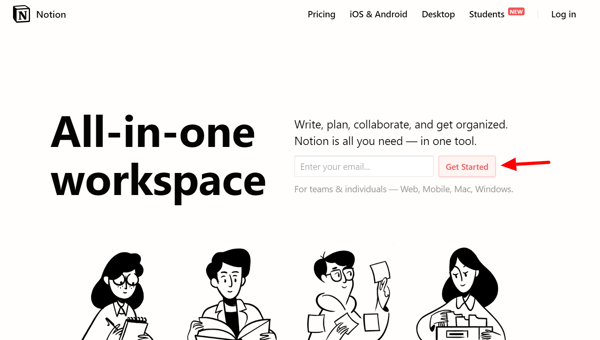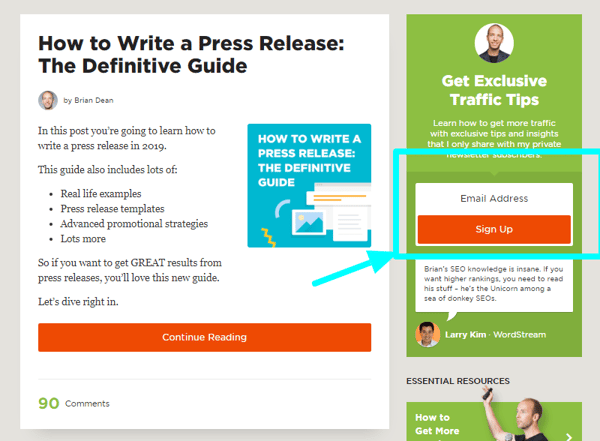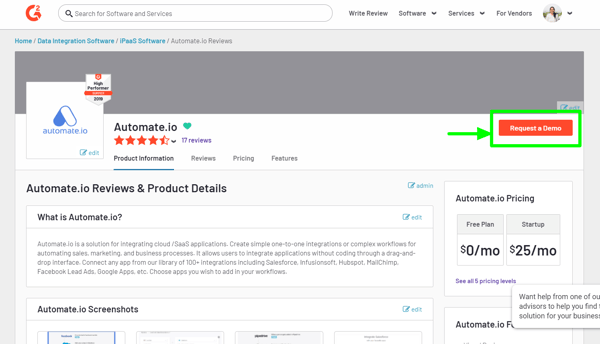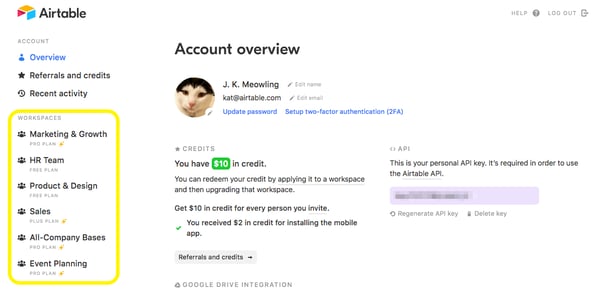
One of the most significant keys to a growing SaaS business is lead generation.
What comes next in the game is lead conversion rates and other aspects of upselling, retention, and managing churn. However, all this only works when you have a successful strategy in place to keep the leads flowing in.
According to HubSpot, a buyer’s journey can be broken down into four stages: attract, convert, close, and delight.
So, let’s get started to understand some unique lead generation tips – particularly for SaaS businesses – along with some examples that have proven to work for many.
Any interruption in between your experience while browsing a website can be annoying. However, while exiting, it may not be.
Users might be done checking out your website, so this is a good opportunity plug in your offering, and it really works. Exit-intent popups have helped BitNinja (B2B SaaS model business) get 65 percent more leads.
Getting visitors on your product pages is a big thing in itself. Emails are the primary way to engage these visitors, and if they don’t sign up for your product immediately, exit popups are a way great way to capture their email addresses.
Why do users exit websites without performing a call-to-action (CTA)? It could be that there was an intent mismatch, pricing concern, or they could be looking at other options in the market. So, based on the intent of the page, you can use different types of exit-intent popups.
A few examples you can use for your SaaS business today if someone is exiting from your pricing page include:
Kamel Ben, a B2B SaaS Marketing Consultant, points out how businesses can go a step further than just creating ebooks as lead magnets:
Implement any of the above in your lead generation strategy, will help increase your leads. Once you have more lead email addresses, you can personalize email campaigns and nurture these leads to convert them to paying customers.
Forms are a great way to collect user data and do more with this data.
The best way to use online form builders is using interactive questions and asking as little as possible, while gathering insights. That’s tricky, but creating engaging forms is an art in itself. Instead of clicking on a CTA and then filling out a form, eliminate the extra step by implementing interactive forms on the website itself.
For example, Notion captures email address via a lead capture along with CTA right in the first fold itself.

Read about an in-depth case study on how HubSpot used Typeform’s interactive forms to boost their lead generation.
The chatbot was a revolution in itself, wherein every company understood the need to implement one for more conversational marketing and understanding website visitors to a greater extent.
Not just that, but companies have started to use conversational chatbots that can be implemented on high traffic generating pages, engaging with website visitors.
The main aim of live chatbots is to prompt users to engage in a conversation and, of course, generate leads. They're also a channel for lead generation.

If at all, user queries are often not solved by a bot itself. Therefore, requesting an email address to contact them with additional details to their query gives you a lead.
Your blog is your content hub. In fact, the most high traffic generating pages could be some of your blog posts.
Utilize this traffic by adding interactive pop-ups prompting users to download a PDF version of the blog post for a later read, subscribe to your newsletter to hear more from you, or check out any of your other offerings – like a webinar, podcast, and so on.

Even before you launch, you can understand the demand for your product and gather leads of interested users.
These leads are the most relevant and important to your business; they provide you with feedback to further improve your product. If you're looking for further instruction, check out this pre-launch checklist for a SaaS product.
For buyers, product listing sites, like G2, are the go-to website to check out the reviews and understand the top players in a particular niche.
If your SaaS product is listed on the most relevant categories of these websites, it promotes your brand to a huge audience. If someone’s interested to know more about your brand, they’ll end up contacting you via the contact forms available.
In this case, users can request a demo by filling out a form.

While there are lead generation opportunities on both Linkedin and Facebook, Facebook Lead Ads are preferred over LinkedIn ones based on cost.
Facebook Lead Ads make lead generation very simple and cost-effective in the pay-per-click (PPC) area compared to other channels. Facebook Lead Ads work the best when optimized for the right audience, targeting, ad copy, and design.
Next time you launch an ebook, re-target your blog visitors on Facebook to generate leads. Learn more about Facebook Lead Ads from Adespresso’s Guide. When considering LinkedIn for lead generation, it's crucial to understand the platform's limitations and strategies, especially regarding how many LinkedIn invites per day you can send. LinkedIn imposes daily limits on invites to prevent spam, but with a strategic approach, including personalized messages and targeting the right audience, you can maximize your lead generation efforts within these constraints.
|
TIP: To make sure you make the most out of your leads, save your Facebook Leads automatically on Google Sheets or connect Facebook lead Ads to email marketing software to run further lead nurturing campaigns. |
Referral marketing has been around the corner for a long time now, and many businesses have already tested it; it works wonders to increase word-of-mouth and generate highly-relevant leads.
We all love goodies. Who wouldn’t love to get rewarded for referring a customer to your business with that new customer also getting a bonus or credit? The best way to reward your referrers is to add credits/points/any key item of your product in their accounts. This not only makes them feel important, but also makes them more loyal to your brand.
One such example of this how Notion and Airtable add credits to your account if a user sign-ups for their products using your referral link.

Source: Airtable
Co-marketing is a key way to tap into a newer audience that you’ve not been able to address through organic channels. Some ideas you can implement for co-marketing activities include: webinars, podcasts, ebooks or other collaborative works, and Twitter chats.
Each of these would have heavy promotions by either of the brands involved through their newsletters, social channels, or websites. That’s how you get access to this new audience to further educate them about your product and convert them to customers.
While some of these may not end up directly generating leads, they will help get more visitors to your website and, in turn, generate leads from there!
Each business is different in its offerings and services, so it’s important to understand that one stand-alone strategy won't work for everyone. There isn’t any set rule to generate leads, and it’s all about experimenting what works for you.
So, pick up the strategies that suit your business the best, experiment, track whether you’re able to generate leads, and optimize the channels that work best for you. And make sure to find the best lead generation software to help you get started today, only on G2.
Archita helps B2B SaaS businesses with marketing (with a focus on content) and is currently doing so for Automate.io. She is happiest while helping founders unleash the power of content marketing and telling stories about her weekend artistic cafe visits!
The pace of online learning has accelerated faster than anyone could imagine in the past...
 by Eduard Klein
by Eduard Klein
You have leads in your CRM. Now how do you nurture and keep them interested in your product if...
.jpg) by Brandon Pindulic
by Brandon Pindulic
Generating leads isn’t just a priority for small businesses and startups anymore. Corporations...
 by Mehdi Hussen
by Mehdi Hussen
The pace of online learning has accelerated faster than anyone could imagine in the past...
 by Eduard Klein
by Eduard Klein
You have leads in your CRM. Now how do you nurture and keep them interested in your product if...
.jpg) by Brandon Pindulic
by Brandon Pindulic


